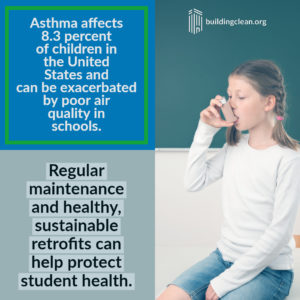Healthy Schools Grow Smarter Students
By the time they graduate from high school the average student will have spent 15,000 hours in a school building. These 15,000 hours are comprised of critical intellectual development and psychological, social, and physical growth. The buildings they go to every school day are instrumental in shaping student health and educational performance.
Not only do school-aged children spend a large portion of their day in school buildings, they are uniquely susceptible to the complex environmental threats that abound today. According to the Healthy Schools Network, children are particularly vulnerable because:
- Their bodies are still developing;
- They eat, drink, and breathe more per pound of body weight;
- They are exposed to more environmental threats; and
- They are least able to recognize exposure risks or take action when exposure occurs.
Inadequate ventilation of school buildings—in conjunction with degrading infrastructure—are leading culprits of children’s exposure to unhealthy chemicals. Without proper ventilation, toxic chemicals are unable to be flushed out and can have prolonged impacts on students’ health.
Asthma is the most common childhood chronic disease, affecting 8.3 percent of children in the United States. Indoor asthma triggers are substantial and include many of the chemicals and exposure routes found in schools. Though asthma is the most widespread, it is far from the only impact that harmful building products in schools have on student health. Exposure to certain chemicals that may be found in flooring, paint, and insulation—just to name a few sources—can lead to lower IQs and educational attainment, as well as reproductive disorders and cancers.
Recently, it was discovered two Indiana elementary schools had unsafe levels of a cancer-causing chemical. The schools have been shut down and are undergoing further testing to determine when it will be safe for children to return to class. Exposure to such a chemical not only interferes with student education by keeping them out of class but could have harmful impacts that may not emerge for years.
Every day, children across our country face environmental hazards and chemical exposures in a place that ought to be safe for them. Encouraging regular school maintenance and healthy, sustainable retrofits is one way that you can join in the fight for childhood environmental health.
Find out more about protecting students and school staff at the Healthy Schools Network.
